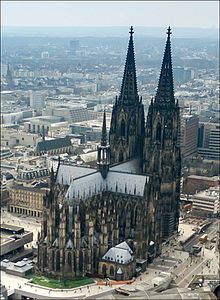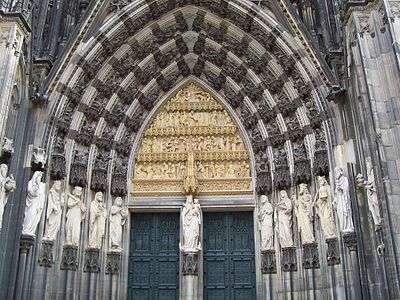
Cologne Cathedral
Cologne Cathedral (German: Kölner Dom, pronounced [ˌkœlnɐ ˈdoːm] , officially Hohe Domkirche Sankt Petrus, English: Cathedral Church of Saint Peter) is a cathedral in Cologne, North Rhine-Westphalia belonging to the Catholic Church. It is the seat of the Archbishop of Cologne and of the administration of the Archdiocese of Cologne. It is a renowned monument of German Catholicism and Gothic architecture and was declared a World Heritage Site in 1996.[4][5] It is Germany's most visited landmark, attracting an average of 6 million people a year.[6] At 157 m (515 ft), the cathedral is the tallest twin-spired church in the world, the second tallest church in Europe after Ulm Minster, and the third tallest church of any kind in the world.[7]
Cologne Cathedral
Germany
Cathedral
Active
- 1248–1560
- 1842–1880
- 1950s–present (restoration)
144.5 m (474 ft)[1]
86.25 m (283.0 ft)[1]
2
157 m (515 ft)[1]
11
Guido Assmann[2]
Robert Kleine
Jörg Stockem
Eberhard Metternich
Winfried Bönig[3]
Ulrich Brüggemann
157.4 m (516 ft)
Cultural: i, ii, iv
1996 (20th Session)
2004–06
Construction of Cologne Cathedral began in 1248 but was halted in the years around 1560,[8] unfinished. Attempts to complete the construction began around 1814 but the project was not properly funded until the 1840s. The edifice was completed to its original medieval plan in 1880.[9] The towers for its two huge spires give the cathedral the largest façade of any church in the world.
Cologne's medieval builders had planned a grand structure to house the reliquary of the Three Kings and fit for its role as a place of worship for the Holy Roman Emperor. Despite having been left incomplete during the medieval period, Cologne Cathedral eventually became unified as "a masterpiece of exceptional intrinsic value" and "a powerful testimony to the strength and persistence of Christian belief in medieval and modern Europe".[5] In Cologne, only the telecommunications tower is higher than the cathedral.[4]
History[edit]
Ancient site[edit]
When construction began on the present Cologne Cathedral in 1248 with the laying of a foundation stone, the site had already been occupied by several previous structures. The earliest may have been for grain storage and possibly was succeeded by a Roman temple of Mercurius Augustus.[10] From the 4th century on, however, the site was occupied by Christian buildings, including a square edifice known as the "oldest cathedral" that was commissioned by Maternus, the first bishop of Cologne. A free-standing baptistery dating back to the 7th century was located at the east end of the present cathedral but was demolished in the 9th century to build the second cathedral. During excavations of the present cathedral, graves were discovered in the location of the oldest portion of the building; including that of a boy that was richly adorned with grave goods and another of a woman, popularly thought to be Wisigard. Both graves are thought to be from the 6th century. Only ruins of the baptistery and the octagonal baptismal font remain today.
The second church, called the "Old Cathedral", was completed in 818. It was destroyed by fire on 30 April 1248, during demolition work to prepare for a new cathedral.[11]
Medieval beginning[edit]
In 1164, the Archbishop of Cologne, Rainald of Dassel, acquired the relics of the Three Kings which the Holy Roman Emperor, Frederick Barbarossa, had taken from the Basilica of Sant'Eustorgio, Milan, Italy.[note 1] The relics have great religious significance and drew pilgrims from all over Christendom. It was important to church officials that they be properly housed, and thus began a building program in the new style of Gothic architecture, based in particular on the French cathedral of Amiens.
The foundation stone was laid on Saturday, 15 August 1248, by Archbishop Konrad von Hochstaden.[12] The eastern arm was completed under the direction of Master Gerhard, was consecrated in 1322 and sealed off by a temporary wall so it could be used as the work continued. Eighty-four misericords in the choir date from this building phase.. This work ceased in 1473, leaving the south tower complete to the belfry level and crowned with a huge crane that remained in place as a landmark of the Cologne skyline for 400 years.[13] Some work proceeded intermittently on the structure of the nave between the west front and the eastern arm, but during the 16th century this also stopped.[14]
The ground plan design of Cologne Cathedral was based closely on that of Amiens Cathedral, as is the style and the width to height proportion of the central nave. The plan is in the shape of a Latin Cross, as is usual with Gothic cathedrals. It has two aisles on either side, which help support one of the very highest Gothic vaults in the world, being nearly as tall as that of the Beauvais Cathedral, much of which collapsed. Externally the outward thrust of the vault is taken by flying buttresses in the French manner. The eastern end has a single ambulatory, the second aisle resolving into a chevet of seven radiating chapels.
Internally, the medieval choir is more varied and less mechanical in its details than the 19th-century building. It presents a French style arrangement of very tall arcade, a delicate narrow triforium gallery lit by windows and with detailed tracery merging with that of the windows above. The clerestory windows are tall and retain some old figurative glass in the lower sections. The whole is united by the tall shafts that sweep unbroken from the floor to their capitals at the spring of the vault. The vault is of plain quadripartite arrangement.
The choir retains a great many of its original fittings, including the carved stalls, despite French Revolutionary troops having desecrated the building. A large stone statue of St Christopher looks down towards the place where the earlier entrance to the cathedral was, before its completion in the late 19th century.
The nave has many 19th century stained glass windows. A set of five on the south side, called the Bayernfenster, were a gift from Ludwig I of Bavaria, and strongly represent the painterly German style of the time.
Externally, particularly from a distance, the building is dominated by its huge spires, which are entirely Germanic in character, being openwork like those of Ulm, Vienna, Strasbourg and Regensburg Cathedrals.[31]
One of the treasures of the cathedral is the high altar, which was installed in 1322. It is constructed of black marble, with a solid slab 15 ft (4.6 m) long forming the top. The front and sides are overlaid with white marble niches into which are set figures, with the Coronation of the Virgin at the centre.[32]
The most celebrated work of art in the cathedral is the Shrine of the Three Kings, commissioned by Philip von Heinsberg, archbishop of Cologne from 1167 to 1191 and created by Nicholas of Verdun, begun in 1190. It is traditionally believed to hold the remains of the Three Wise Men, whose relics were acquired by Frederick Barbarossa at the conquest of Milan in 1164. The shrine takes the form of a large reliquary in the shape of a basilican church, made of bronze and silver, gilded and ornamented with architectonic details, figurative sculpture, enamels and gemstones. The shrine was opened in 1864 and was found to contain bones and garments.
Near the sacristy is the Gero Crucifix,[33] a large crucifix carved in oak and with traces of paint and gilding. Believed to have been commissioned around 960 for Archbishop Gero, it is the oldest large crucifix north of the Alps and the earliest-known large free-standing Northern sculpture of the medieval period.[34]
In the Sacrament Chapel is the Mailänder Madonna ("Milan Madonna"), a high Gothic carving, depicting the Blessed Virgin and the infant Jesus. It was made in the Cologne Cathedral workshop sometime around 1290 as a replacement for the original which was lost in a fire. The altar of the patron saints of Cologne with an altarpiece by the International Gothic painter Stefan Lochner is in the Marienkapelle ("St. Mary's Chapel").
After completion in 1265, the radiating chapels were immediately taken into service as a burial place. The relics of Saint Irmgardis found a final resting place in the St. Agnes' Chapel. Her trachyte sarcophagus is considered to be created by the cathedral masons' guild around 1280.[35]
Other works of art are in the Cathedral Treasury.
Embedded in the interior wall are a pair of stone tablets on which are carved the provisions formulated by Archbishop Englebert II (1262–67) under which Jews were permitted to reside in Cologne.[36]







